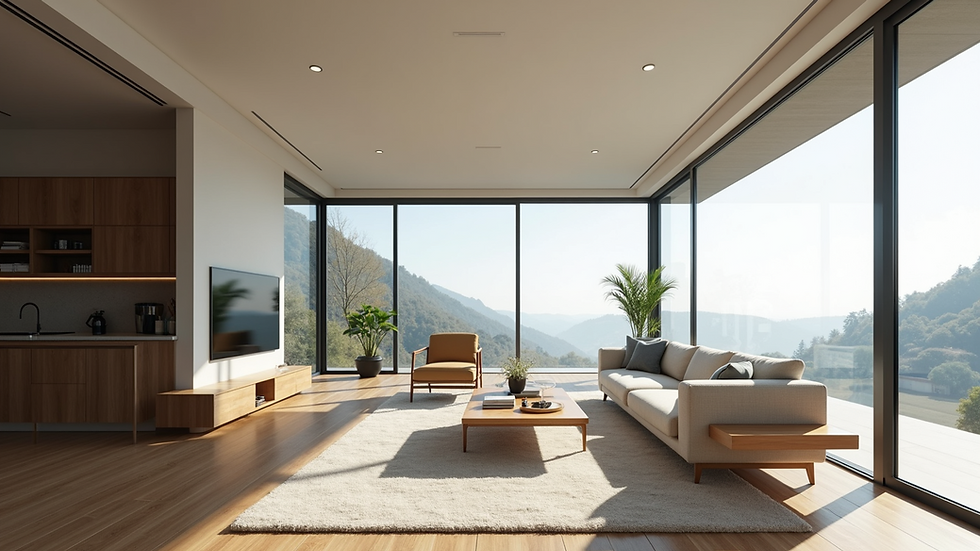Transforming Spaces: Exploring Smart Glass in Modern Interior Design with Visual Inspiration
- Journalising Designers
- Jul 3, 2025
- 4 min read
In the fast-paced world of interior design, technology has become essential for creating modern, functional spaces. One groundbreaking innovation transforming this field is smart glass. Not only does it elevate aesthetics, but it also enhances functionality and promotes sustainability. Smart glass is reshaping how we think about our living and working environments.
What is Smart Glass?
Smart glass, commonly referred to as switchable glass, is a type of glazing that adjusts its properties in response to electrical currents, light, or temperature. It can transition from clear to opaque, offering privacy on demand while enhancing natural light in a space. This adaptable solution is particularly appealing for contemporary homes, offices, and public spaces seeking to blend beauty with practicality.
Types of Smart Glass
There are several types of smart glass available, each with unique features and applications:
1. Electrochromic Glass
Electrochromic glass changes tint when an electric current passes through it. This feature allows users to control sunlight entering a room effectively. For example, a study showed that using electrochromic glass in office buildings can reduce energy costs by up to 30% by minimizing reliance on air conditioning.
2. Photochromic Glass
Photochromic glass automatically tints in bright sunlight and returns to a clear state in lower light. It is ideal for homes with large windows—as seen in many modern builds—that need protection from harsh sunlight. For instance, using photochromic glass in east-facing windows can reduce UV exposure by more than 50%, protecting furniture and flooring.
3. Thermochromic Glass
This type of glass changes opacity based on temperature changes. In locations with hot summers and cold winters, thermochromic glass helps maintain indoor comfort by blocking heat during peak summer while allowing warmth in winter. Buildings utilizing this technology can see a 15-20% improvement in energy efficiency over traditional glass.
4. SPD (Suspended Particle Display) Glass
SPD glass utilizes suspended particles that realign when an electrical current is applied, allowing users to control light and heat transmission. This technology is ideal for larger installations, such as conference rooms or event spaces, as it provides advanced climate control while enhancing visual appeal.
Practical Uses in Interior Design
Smart glass has a wide range of practical applications in interior design. Here are some notable examples:
1. Privacy Screens
Smart glass partitions can replace traditional walls, providing privacy without the need for physical barriers. For instance, in a home office, glass that transforms from translucent to transparent allows instant adaptability for private meetings or calls.
2. Skylights
Integrating smart glass into skylights helps to manage heat and light effectively. In a living room, this technology can create a more comfortable environment and reduce reliance on artificial lighting by allowing natural light to flood the space during the day.
3. Shower Enclosures
The luxury of stepping into a bathroom with a shower enclosure that switches from clear to frosted glass at the touch of a button enhances privacy without compromising the open feel of the room. This innovation can elevate the bathroom experience significantly, making it feel like a spa retreat.
4. Facades
Modern architecture often features smart glass facades. For example, a notable building in Dubai incorporates smart glass to reduce energy consumption and enhance the visual aesthetics of the structure, adjusting its heat absorption throughout the day, thereby improving its energy efficiency by about 18%.

Visual Inspiration
Using smart glass in interior design creates striking visual narratives while ensuring practicality. Consider these ideas:
Contemporary Living Spaces: Smart glass can create fluid connections between indoor and outdoor areas. This design approach blurs boundaries, enhancing the overall spatial experience and creating dynamic environments.
Innovative Workplaces: Rather than traditional cubicles, smart glass can define collaborative zones that offer the flexibility to create private areas as needed. This promotes an atmosphere of transparency while addressing privacy concerns effectively.
Luxury Bathrooms: Incorporating smart glass into bathroom designs can add elegance and modernity. This solution maintains privacy while enhancing the overall aesthetic, creating a spa-like atmosphere.
Benefits of Smart Glass
Smart glass brings numerous advantages to interior design:
1. Enhanced Comfort
By effectively controlling light and temperature, smart glass contributes to a more enjoyable living and working environment. For example, studies have shown that offices using smart glass report a 25% increase in employee comfort and satisfaction.
2. Energy Efficiency
Smart glass can lead to substantial energy savings by reducing the need for artificial lighting and climate control systems. Reports suggest that buildings using smart glass can cut energy costs by up to 20%, ultimately lowering monthly utility expenses.
3. Increased Property Value
Modern technologies like smart glass can significantly boost a property's value. Homes featuring such advancements tend to attract buyers interested in contemporary, efficient designs, often resulting in sales prices that are 10-15% higher than similar properties without smart glass.
The Future of Smart Glass in Interior Design
As technology advances, the possibilities for smart glass in interior design will expand. Future innovations will likely yield even more responsive solutions that not only enhance aesthetic appeal but also promote environmental sustainability. Homeowners and designers will continue to explore ways to incorporate smart glass into various applications, bringing both beauty and functionality to spaces.
Embracing Smart Glass in Interior Design
Smart glass is transforming interior design by offering versatility, creativity, and advanced technology. As designers and homeowners embrace this innovative material, they can create inspiring spaces that balance beauty with practicality. By integrating smart glass into various applications—from homes to commercial environments—it's possible to craft transformative experiences that enhance our everyday lives.

